In Giabal and Jarowair country.
We are pleased to report that we are not suffering from the DOMS (Delayed Onset Muscle Soreness) that we were warned could ensue from our Moss Garden Walk two days ago! We Moss Garden walkers believe this could be due to our frequent daily climbs onto and off the coach. It’s only a few steps but they are steep and deep, and we do it several times a day. Make sense? Either that, or we are all super fit!
Anyhow, on with the itinerary:
“This morning we visit the Big Rig Oil Patch for an informative tour before heading east along the Warrego Highway passing through Miles, Chinchilla and Dalby.
[I’ve deleted the stuff about Dalby because we didn’t stop there!]
This afternoon we arrive in Toowoomba where we enjoy a tour of this strong, regional city, including the Cobb & Co Museum. Toowoomba is the largest non-capital inland city in Australia with a population of approximately 150,000. It is well known for its many beautiful parks and gardens which benefit from the town’s rich volcanic soils.”
In Roma
We started the day, by staying in Roma, first visiting Roma’s Largest Bottle Tree (brachychiton rupestris), which was transplanted from a property in 1927. It was a beautiful thing, but as happened more often than not, the lighting for photography was not perfect. I wanted to photograph many bottle trees over the trip, because they are such an appealing tree, but usually we were whizzing by. (For those of you who are wondering, they behave much like baobabs, Adansonia genus, of which the Australian boab tree is one, but they are a different species, belonging to the Brachychiton genus.)
Next it was The Big Rig (“Australia’s Living History of Oil and Gas Exploration”). With Len’s background in oil and gas well wireline logging, having worked with Schlumberger Verfahren in Germany/Austria/Italy in the 1970s, he was looking forward to this.
The tour was led by an employee of Origin Energy, and she started by paying respects to the local people, which, unless I’ve forgotten something, is the first time in the trip this has happened. She also told us that “no question” was off limits, but no one asked any questions. This may have been due to politeness, or maybe because we didn’t really want to prolong the tour!
She walked us around the tour route reading out signboards at times (which didn’t go down well), taking us through the roller-coaster history of oil and gas discovery and exploration in the area, and through the extraction technologies used over time. I’m afraid many eyes glazed over, and I don’t think those eyes were limited to one gender! There were some interesting historical facts, such as the fact that in 1905, Roma was the first place in Australia to have street lamps lit by gas. The only trouble was that the lights ran out after ten nights! This was part of the roller-coaster as they worked to understand what they had.
She also went through how they negotiate, using their Conduct and Compensation Agreement process, putting gas wells on properties. But, she said, the first thing they do when a new site is found is a cultural assessment. It is a no-go zone if the site has serious cultural significance – but it’s clear that a bit of argy-bargying goes on in terms of how significant.
While all this was interesting – to a point – it did feel a little too promotional to many of us. And it took all the time we had at the site, so we did not get to go up the Big Tower as our tour leaders had recommended. (I should add that Len, for whom the history was technically interesting, found it all a bit over simplified!)
Someone must love all this, because apparently this year Roma earned Bronze in Australia’s Top Tourism Town Awards, having won Gold in the state awards. A bit astonishing, but, good on Roma for its hard work.
We had our morning tea in the grounds there, and then left Roma, but as we drove out, Roma’s cattle yards were pointed out. Here are held the biggest cattle sales in Australia. Our tour leaders told us that more and more woman are coming into the industry because cattle tend to be calmer around women! Calmer cattle are easier to manage and make good meat!
I should also add, before we leave Roma, that it was the site of some serious First Nations resistance to settlement, through the 1840s and 50s. Many deaths occurred in several incidents (or “skirmishes”). Of course, as history shows, the resistance was eventually quashed.
En route to Chinchilla … and Chinchilla
As we left Roma, we were told we’d be seeing the full gamut of energy provision en route to Chinchilla – solar and wind farms, gas and coal power stations. And we did. We were also told that we’d see many silos but no silo art. I guess that was to fend off the inevitable questions from we silo-proud southerners!
Our tour leader also told us the prickly pear (opuntia) story. As many older Australians know, prickly pear was a huge pest in Australia’s past – in this area from around 1890s. Solutions were sought and tried for a long time, but it was around the 1920s that scientists turned to the plant’s South American origins. What keeps it under control where it originates? The cactoblastis moth. The moth was released in this area in the early 1930s and by end of decade the opuntia was mostly cleared. We saw scattered plants by the road side over the two or three days we were in the area but they are no longer a problem. This was a successful biological solution because this moth does not lay its eggs ANYWHERE else but on the prickly pear!
As we drove through a town called Dulacca, our tour leaders pointed out a wind farm. The wind turbines have 90 metre blades and noise reduction features, and they are now recyclable, when they wear out but they are also lasting longer. Landowners get paid around $34,000 per tower per annum. They need to provide access to the energy company for maintenance, but they can continue to use the land for grazing. However, this can set up bad feelings between property owners who have and their neighbours who don’t.
We also learnt that a rabbit-proof fence is now being built in the Darling Downs! Our tour leaders were a mine of information, much of it coming from developing relationships with locals.
We lunched in a park in Chinchilla, a local First Nations name for the area given by Leichhardt, who had asked the locals for the name of the local cypress pines. Chinchilla is famous for melons. Not only do they have an annual Melon Festival, but they now have a Big Watermelon (which was given to the community by wotif!) The park here was just gorgeous, perfect for our last coach lunch of the tour.
For our final driving stage of the day, which included more “lumpy” roads, our tour leaders distracted us by playing a recording of a “clean” Irish comedian, Hal Roach. In one sense, it felt an odd choice, but he really was funny. One of his last jokes concerned aging, and that “Mirrors are not as good as they used to be”. Haha!
Now that we were on the Darling Downs, we were out of the pastoral industry and into agriculture – with grains, and cotton being big crops in the area. Dalby has a major cotton gin.
Toowoomba
We arrived in Toowoomba, located at the top of the Great Dividing Range (700m). Its name is believed to be First Nations in origin.
Toowoomba, with its fertile soils, is famous for its gardens, and we were here right at Flower Festival time. The streets were lined with trees, including Camphor Laurels, which have been eliminated elsewhere as a noxious weed, but not Toowoomba.
We visited two places this afternoon:
- Cobb & Co Museum, which was created to house Bill Bolton’s Cobb & Co collection. This museum is more than “just” a museum of artefacts. In a major redevelopment around 2010, they included a factory area to support heritage trades. They run workshops in trades like blacksmithing, silversmithing, stonemasonry, millinery, leather crafting, felting, glass art, calligraphy, leather plaiting, and creative bookmaking. We were given a tour, mostly of the Coach Room. Who doesn’t love looking at old coaches?
- Queens Park, with its Flower Festival/Carnival of Flowers displays. We had 45 minutes here. It was a gorgeous afternoon, and there was quite a diverse community enjoying the flower beds. We all enjoyed wandering around, but we were also all ready for the coach when time was up!
The day ended with the end-of-tour dinner. The food was disappointing, given we were back in a more urban environment – my barramundi was rubbery, for example – but the main point was the socialising, and that was great (especially for Len and me who had been starved of it most of the trip!) Our tour leaders did a quick wrap-up of the tour, listing all we’d done, and telling us that by the end of the tour we would have travelled over 4,300kms in the coach. We had each been asked for our highlight of the tour – quick, off the cuff, no over-thinking! The top two for our tour group were Cobbold Gorge (my vote, and that’s not really because of my family connection) followed by the Stockman’s Hall of Fame (Len’s vote). These are common across the tour groups, apparently, with some other sites mixing it up a bit, like Carnarvon Gorge (which was high for me). The funny thing was I had been asking my dinner neighbour about our highlights of the tour, so we were ready to go!




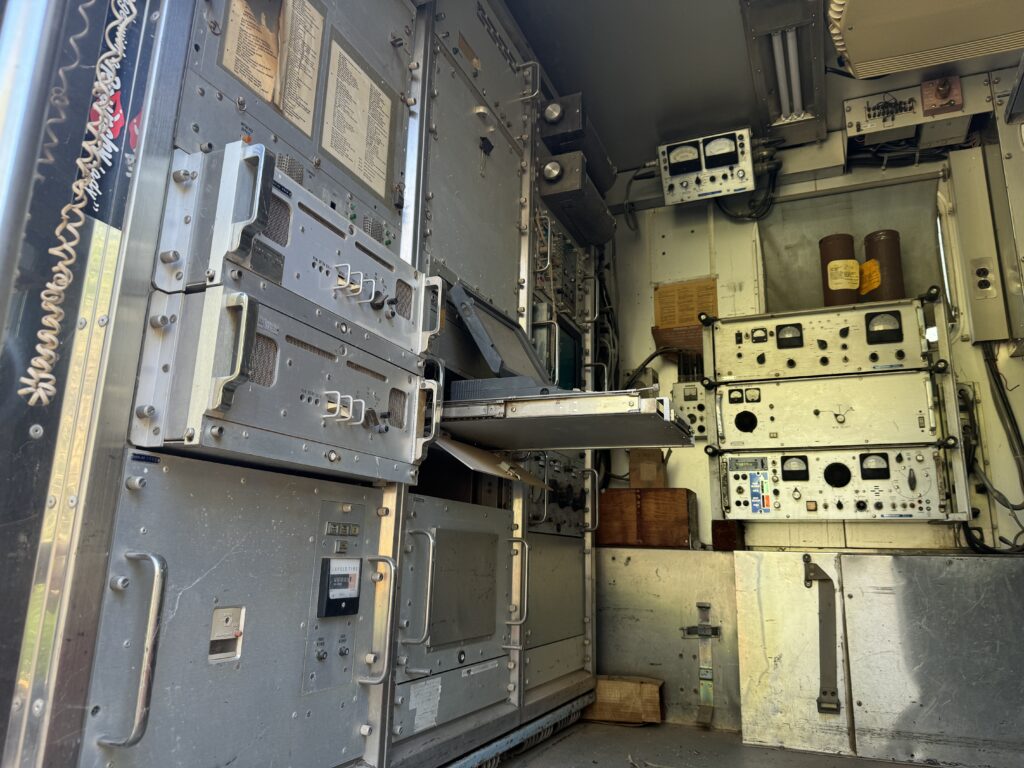
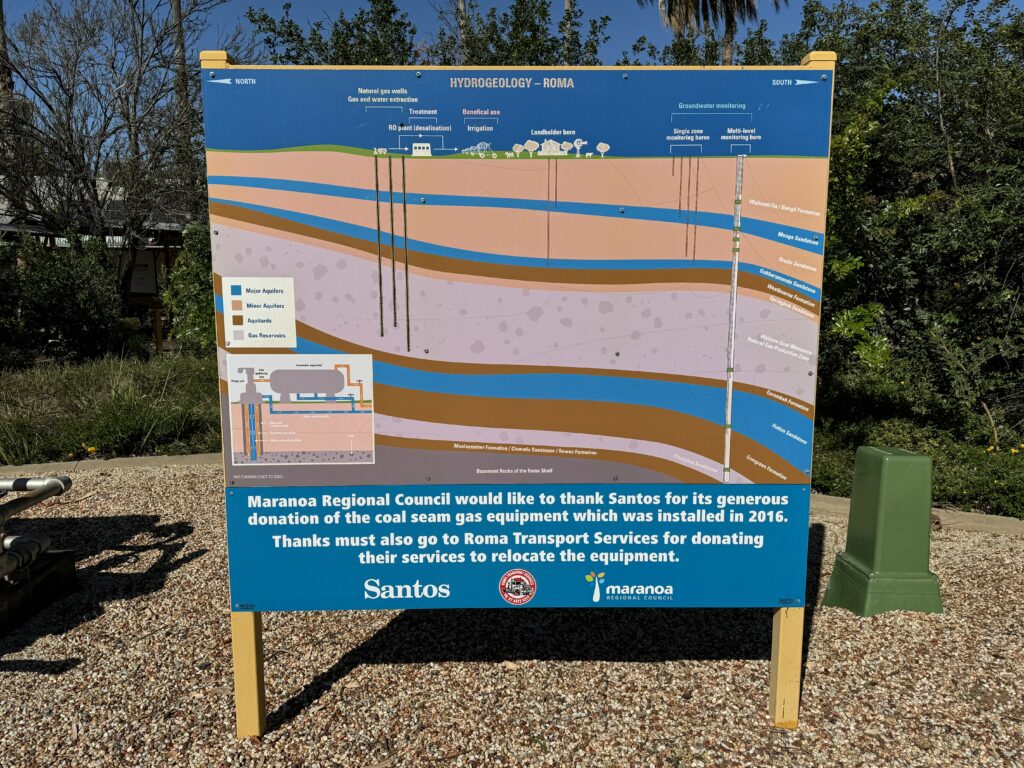

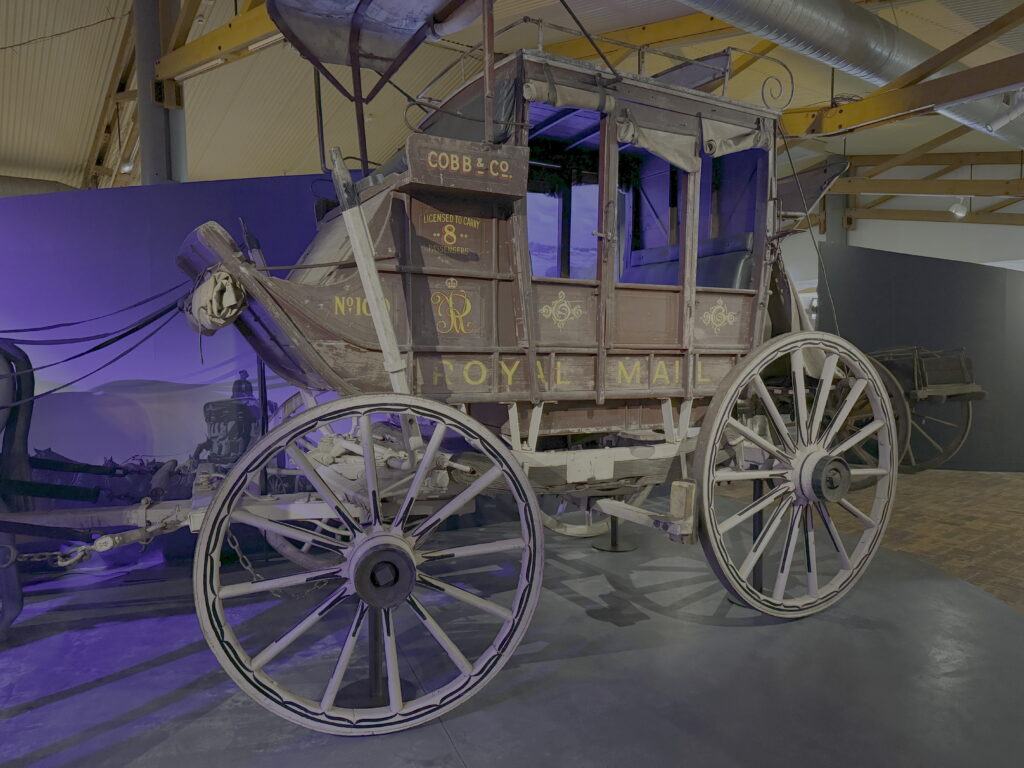

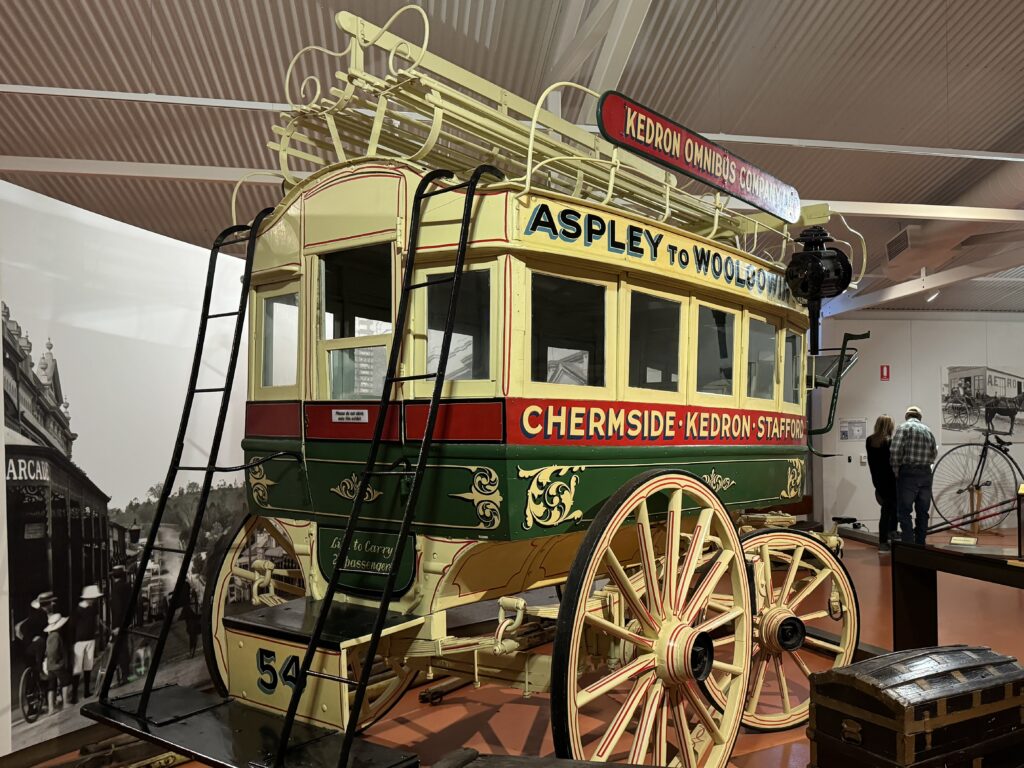


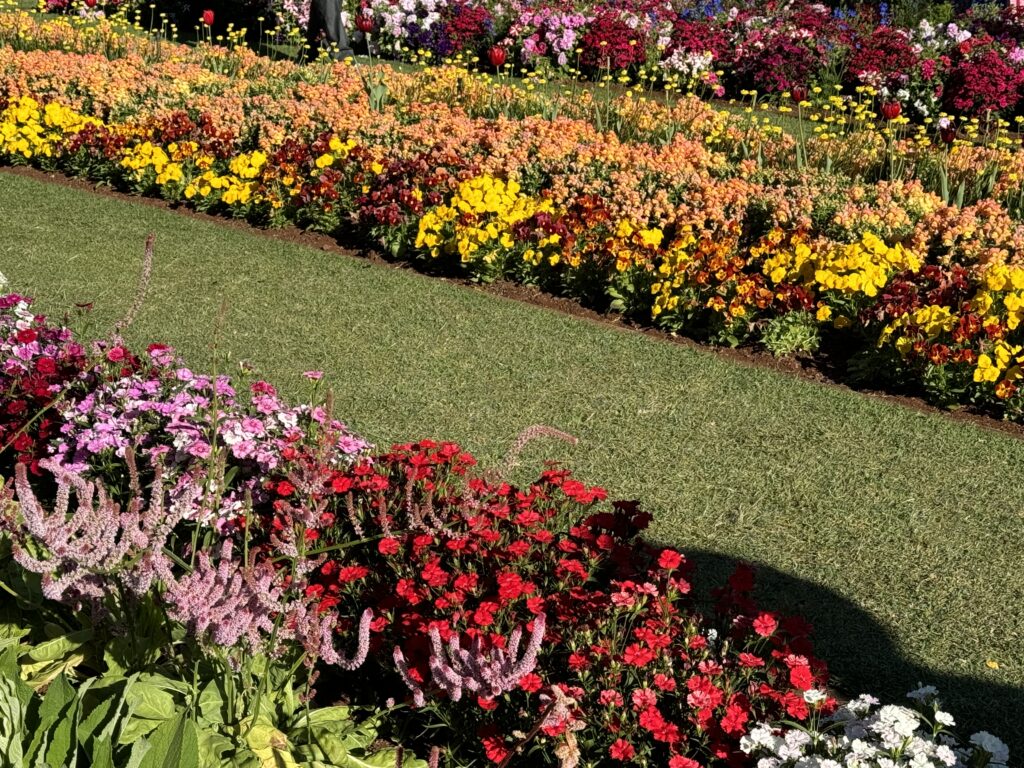

Thanks for the lovely photos of the Flower Festival in Toowoomba ~ those displays are magical! You definitely visited at the right time. Fancy going in a journey in one of those pretty Cobb & Co coaches ~ although they would not be anywhere near as comfortable as your tour bus. A shame you didn’t get to go up the tower at the Big Rig stop. I bet the guide there might have been surprised and maybe a little shy to realise that they were presenting to a professional expert in Len. It’s interesting that each of your highlights were popular amongst the group (and other tour groups) too. It is a strong recommendation for those locations. A 4,300 km outback road trip is a major achievement! Hopefully, in the future, these notes and images you have shared with us will trigger many more good memories of the people you met and places you saw. Well done both of you!
Thanks Mary … yes, the Big Rig person didn’t check for experts in the group the way our Lava Tubes guide did!
The flowers were beautiful and made It made me think of course of Floriade – similarities and differences. This festival is 75 years old!
Writing the blog has been tough at times but as well as keeping in contact with family and friends, there is great value for us in the record.
What a trip ya’ll are having! Jam packed every day with so much to see. The gardens are beautiful. The museums! I love the Moss gardens BUT it does not look like a leisurely stroll. Of course, ya’ll are extremely fit! Good on both of you, not only for taking good care of yourselves, BUT for living an active life style….. that you both love, thrive in and enjoy! Not the least surprised but impressive for sure. I love the information on the moth and cactus! What a wonderful solution and a grand outcome. I love it when environmental challenges reach a safe and successful solution. Traveling with the two of you is ALWAYS an education and a pleasure.
Thanks Trudy … the cactus and moth story is such a special success I think. I’m sorry we didn’t have more critters for you (or for us!) we did see some more but always from the coach.
Your day was certainly jam packed today and it was good that y’all had no delayed onset muscle soreness. I’m guessing that everyone who chose that strenuous hiking option knew that they could handle it and that the guides just underestimate the oldsters. Anyhow, a few things stood out from all the things you saw and heard yesterday. First, I never knew that Len had such expertise in oil and gas line wire line logging, and I don’t even understand that job description, I’m even more impressed! Second, that story of how moths were used to control the invasive prickly pear was fascinating. Your visit to the wind farm was something I would like to do someday. Oh, how could I not love the big watermelon? Lastly, though I wasn’t on your tour, your pictures also made me like the Cobbold Gorge best of what you experienced. It was otherworldly.
Suspect you are right about us knowing our limits and the tour leaders, bring around 50 – maybe tops – is my guess, can’t guess at the fitness of the elderly!!!
Must go for coffee – Len liked in that are for about a year, mostly in Germany, since I met him and had retained a useful knowledge snd interest. He was involved it taking measurements what drillers thought they had found (but that’s my very simplistic explanation!!!)
Cobbold Gorge really was otherworldly.